Tim Warnes's Blog: My Life in Books, page 8
January 21, 2022
I am the Subway
Today’s recommendation is a Korean picture book: I am the Subway by Kim Hyo-eun (translated by Deborah Smith). An unforgettable and moving glimpse into Korean lives – narrated in the first person by a train on the Seoul subway network (green line #2, to be precise).
But it’s not a guide to the city, per se. Instead, I am the Subway shares stories about the train’s passengers via their own thoughts (differentiated from the train’s voice by italicised text). It’s genius – and lends the feeling that the train is letting us in on many secrets. (When I first read it, I got goosebumps and clapped aloud.)
The story begins:
I rattle and clatter over the tracks.
Same time, same route, every day.
Carrying people from one place to another…
These opening spreads set the scene. Soft and monochromatic, the crowds of people are featureless, anonymous. They are in constant motion, overlapping in ghostly watercolour washes as they pass through ticket barriers and gather to wait on the platform.

The train’s narration continues:
I travel over the ground and rumble under,
twice across the Han River.
Around I go, around and around.
Crowds of people wait to climb aboard.
ba-dum, ba-dum
I AM THE SUBWAY.
The story shifts gear as the train pulls into Hapjeong station – ba-dum, ba-dum. Now our attention is on the individual passengers - people that the train embraces each day. Detail is added to previously blank faces. Now colour and expression bring them to life and draw them out of the crowd – starting with Mr Wanju.
Racing to catch the train to work, Mr Wanju takes ‘the stairs three or four at a time, all the way to the platform.’ (He’s already looking forward to seeing his daughter’s smile at the end of his working day).

The train, with its ‘mechanical, rhythmic, motion’ [Kirkus] continues its journey…
ba-dum, ba-dum, ba-dum, ba-dum
This station is City Hall, City Hall station.
(The effect of that rhythmic refrain – ba-dum, ba-dum – is soothing and so evocative.)
The next passenger to get on board is Granny. She’s taking fresh fish to her family in Seoul (“I’m going to cook a feast for my girls!”).
I love how the illustrations in I am the Subway raise questions. For example, a sequential image shows Granny diving as a girl and gradually getting older. It begs the question: Did Granny go diving and catch those fish herself?

The answer is yes! (In the tradition of the haenyeo (female free divers) of South Korea’s Jeju province.) But you have to do your own research to work that out! Which makes Subway an excellent book for nurturing curiosity and engaging children with enquiring minds.
Notably, I am the Subway is full of warmth and respect, sharing the highs and lows, hopes and dreams of the various passengers. It feels intimate and is very moving, with incidental details adding to the warmth. Here are some examples from the book to show you what I mean.
Outside Mr Jae-sung’s cramped cobbler shop, a cat and kitten eat from a saucer.
[image error]Granny shares lollipops with a frazzled mum’s kids.
Overworked student, Na-yoon, boards at Gangnam station (that’s right, as in the hit song Gangnam Style), her mood – like her grades – going ‘up and down like a roller-coaster.’ (‘Poor Na-yoon’s feelings,’ comments the train, ‘are as heavy as her bag.’)
And Mr Gu the peddler, with his latest, ‘amazing’ product: one size fits all gloves. (‘All the colours of the rainbow, there’s no colour I don’t have. Just 1,000 won each!’) With tenderness, the train reveals that Gu’s fancy sales pitch is a front of false bravado:
Mr Gu looks embarrassed. I can see him blush as he pushes his cart into the carriage.

At Shillim station, a gentle man whose heart is filled ‘with bright, shining things’ boards the carriage:
I am Lee Do-young,
29 this year.
Everybody has places to go, things to do,
but not me. I’m looking for a job.
(Motionless, Do-young stands facing one way, while a sea of commuters all head past in the opposite direction.)
I’m not sure what’s next.
Who will I become?
Questions, questions!
And all the while, the train rattles and clatters – ba-dum, ba-dum, ba-dum, ba-dum – running ‘in one big ring around the city of Seoul each day, sending people off and welcoming them on.’

Initially portrayed as grey and faceless, the crowd of passengers are now shown as colourful, idiosyncratic individuals. Unique people that make up a larger crowd, held in the embrace of the train. Checking their phones, falling asleep, deep in thought.
The story ends with ‘a gentle afternoon light that washes over everything –/old shoes, new shoes, clean and dull shoes’ – one of many cinematic moments throughout the book.

In the words of our narrator, the train, this story is a celebration of ‘[t]he unique lives of strangers you might never meet again’. It’s a reminder to be present and notice the small details of life that pass us by. And to recognise that we are, in part, all connected.
STORIES WORTH SHARINGI Am The Subway by Kim Hyo-eun (translated by Deborah Smith)(Scribble, 2020)Good to Read for:its poetic languageintroducing the idea of being a global citizennurturing curiosityText & Illustrations © 2016 by Kim Hyo-eun | Translation © 2020 by Deborah SmithGOOD TO READPicture books about journeysKing of the Sky by Nicola Davies & Laura Carlin
The Little Boat by Kathy Henderson & Patrick Benson
I am the Subway by Kim Hyo-eun (translated by Deborah Smith)
The Way Back Home by Oliver Jeffers
Hike by Pete Oswald
Last Stop on Market Street by Matt de la Peña & Christian Robinson
There is a Tribe of Kids by Lane Smith
BUY THE BOOKPowered by Bookshop.org
Supporting independent bookshops
 “A beautiful glimpse into Korean daily life.”– Tori Thompson, GoodReads
“A beautiful glimpse into Korean daily life.”– Tori Thompson, GoodReads“An unforgettable journey.”– Julie Danielson, Bookpage BUY UK BUY US * I EARN COMMISSION FROM THESE LINKS #AD/AFFRELATED ARTICLESSOURCESI am the Subway by Kim Hyo-eun (translated by Deborah Smith) (Scribble, 2020) I am the Subway (scribepublications.com) I am the Subway (Kirkusreviews.com, 2 June 2021) I am the Subway (Publishersweekly.com) I am the Subway: trailer (Scribble Books, Youtube, 4 August 2021)© 2022 BY TIM WARNES(UNLESS OTHERWISE ATTRIBUTED)****USE OF THIRD PARTY COPYRIGHTED MATERIAL FALLS UNDER FAIR USE/FAIR DEALING PRACTICE.
January 14, 2022
The Snatchabook
So wonderful it demands to be read out loud.— Brian SelznickThe Snatchabook by Helen Docherty, illustrated by Thomas Docherty(Alison Green Books, 2013)Good to Read for:snuggling up with your childmodelling friendshipreading out loudThe Snatchabook by Helen Docherty, illustrated by Thomas Docherty (Alison Green Books, 2013) takes me back to reading with my youngest (we borrowed this from the library).
This is one of the qualities of picture books that I love – they create connections and form memories of precious time spent with our children.
So it’s perhaps fitting that a celebration of bedtime stories is at the heart of this charming tale.
The mystery begins immediately on the opening spread:
One dark, dark night in Burrow Down,
A rabbit called Eliza Brown
Found a book and settled down…

This is the first of many fantastic ‘cut-away’ images. And it’s a great device (like we’re being let in on a secret)! What’s not to love about peeping inside a hollow tree and down into the hidden burrows? Kids are treated to seeing the inhabitants of Burrow Down ( badgers, bunnies, owls and squirrels) enjoying their bedtime stories. (These kinds of images (famously used in Jill Barklem’s Brambly Hedge series) are great for sparking curiosity and creativity in your child.).

The animals’ homes are warm and cosy, contrasting nicely with the cool nighttime colours of the windswept world outside. And there, silhouetted against a full moon, the Snatchabook flies into town. The detailed illustrations look so magical and intriguing. And Docherty’s flowing rhyme (with echoes of Dr Seuss) make this an absolute pleasure to read aloud.
In every house,
in every bed,
A bedtime book
was being read.
Tales of dragons, spitting flames;
Witches playing spooky games;
Pirates on the seven seas;
Princesses, trying to sleep on peas.
And every child, in every bed,
Listened hard to each word said.

It couldn’t be more idyllic!
But there’s trouble brewing: While Eliza is reading quite contentedly, there comes a thief in the night! In the blink of an eye, her storybook just disappears! (‘Eliza found that very weird.’)
The same thing happens in other homes, too. Books mysteriously disappear with little more than a Tap, tap! at the window.
The clever use of thought balloons reveal that the inhabitants of Burrow Down begin to suspect one another, and rumours spread ‘of book thieves under every bed.’ Fortunately, our heroine, Eliza Brown, is ‘keen to solve the mystery.’

Using a stack of books as bait, she bravely lies in wait. Hours pass, then suddenly! ‘a flap of wings: a bat? A bird?’
One of the story’s strengths is that children are in on the mystery from the very start. The creators share the inside knowledge by introducing the harmless-looking Snatchabook in the opening spreads, empowering young readers. In doing so, they also remove any sense of danger. So rather than being scary, the Snatchabook is cute.
(Author Docherty explains how, early in the writing process, she decided a thieving monster would be too frightening for a children’s book: “And that’s how I started to imagine a tiny creature [that] creeps into the bedrooms flies in through the windows and steals their books.”)
Despite letting kids in on the secret, the book thief remains enigmatic. Because, thanks to the clever story structure and beautiful illustrations, kids experience it vicariously through the woodland characters instead!
Nevertheless, the moment the Snatchabook is lured to Eliza’s trap is suspenseful.
What kind of monster could it be?
Eliza thought: “You don’t scare me!”
And yet, her heart was beating fast –
She’d have to face the thief at last…
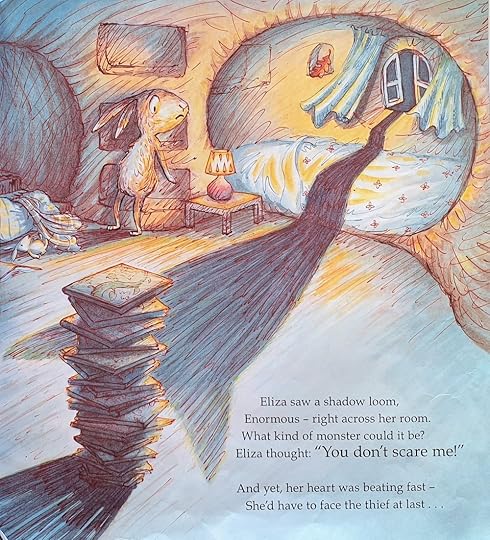
Kids will be hooked as an enormous shadow reaches in from the night outside, over Eliza’s bed (who hides in the shadows) and across the room towards the pile of tempting books!
The suspense mounts further with the page turn: Eliza throws open her window – but there’s no one there!
She shouts to the Thing outside:
“Stop stealing all our books, right now!
Just give them back, I don’t care how!”

And that’s when Eliza (and the reader) is finally introduced to the Snatchabook.
Small, pitiful and fairy-like (trailing a smattering of magic dust).
Clutching at a copy of The Three Bears.
The creature hung its head in shame.
He mumbled, with a mournful look,
“I’m just a little Snatchabook.”
Eliza is kind and wise. She sits the tiny creature on her knee and explains, “You can’t just come and help yourself/To every book on every shelf!”
The remorseful Snatchabook explains that he has no one to read to him.
[image error]
Eliza sighed. He looked so sad.
If he just had a mum or dad
To read him stories every night –
Well, then he might behave all right!
(If this doesn’t strengthen your child’s empathy muscle, then I don’t know what will!)
Eliza makes a plan to help her new friend make amends by returning ‘all the books he’d nicked. (Eliza Brown was very strict.).’ After which she introduces the Snatchabook to all her friends, explaining how ‘he’d worked all night/To turn a wrong into a right.’
And they all lived happily ever after, with cosy bedtime stories each night (to which the Snatchabook was always welcome). And you can’t get much more feel-good than that!
Because as the book’s strapline says: Everybody needs a bedtime story.
 STORIES WORTH SHARINGThe Snatchabook by Helen Docherty, illustrated by Thomas Docherty(Alison Green Books, 2013)Good to Read for:snuggling up with your childmodelling friendshipreading out loudText excerpts © 2013 by Helen Docherty | Illustrations © 2013 by Thomas DochertyGOOD TO READSuspenseful picture books with mystery and intrigue!
STORIES WORTH SHARINGThe Snatchabook by Helen Docherty, illustrated by Thomas Docherty(Alison Green Books, 2013)Good to Read for:snuggling up with your childmodelling friendshipreading out loudText excerpts © 2013 by Helen Docherty | Illustrations © 2013 by Thomas DochertyGOOD TO READSuspenseful picture books with mystery and intrigue!The Grotlyn by Benji Davies
Olivia… and the Missing Toy by Ian Falconer
I Want My Hat Back by Jon Klassen
Lavender by Posy Simmonds
DANGEROUS! by Tim Warnes
BUY THE BOOKPowered by Bookshop.org
Supporting independent bookshops
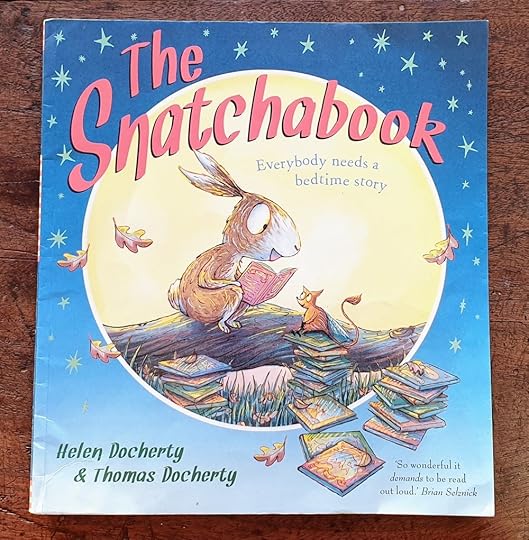
“I was so excited to share it with [my class].”– Brittney Lara, GoodReads“Buy this book for your kids or grandkids. It’s absolutely wonderful.”- Jenni, GoodReads BUY UK BUY USA * I EARN COMMISSION FROM THESE LINKS #AD/AFFRELATED ARTICLESSOURCESThe Snatchabook by Helen Docherty, illustrated by Thomas Docherty (Alison Green Books, 2013) Children's Review: The Snatchabook (shelf-awareness.com) Brilliant Books Author Thomas and Helen Docherty - The Snatchabook (Brilliant Books, youtube.com, 4 November 2014)The Snatchabook on GoodReads © 2022 BY TIM WARNES(UNLESS OTHERWISE ATTRIBUTED)****USE OF THIRD PARTY COPYRIGHTED MATERIAL FALLS UNDER FAIR USE/FAIR DEALING PRACTICE.
January 7, 2022
I Love You to the Moon and Back
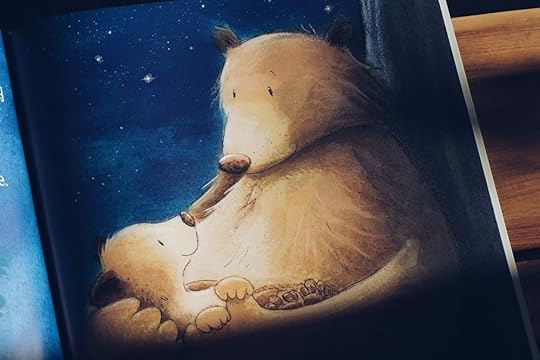
For the last six years, I have ended my night reading Moon and Back to my son. Thank you for making every night special.— Jim Foley, USAI Love You to the Moon and Back/Forever and a Day by Amelia Hepworth, illustrated by Tim Warnes(Little Tiger Press, 2015/2021)Good to Read for:calming down before bedtimesnuggling up togetherexpressing love to your childI have a deep-seated belief that picture books can change the world.
So let me start the New Year by saying: Picture Books are awesome!
Yes, yes – I know I’m biased! But think about it. Quality picture books (the kind I take time to share on this blog):
provide an opportunity for emotional and physical connection
help you nurture the kids in your care.
Amid frantic, busy lives, bedtime stories can provide a lifeline.
They signal to your child: You are worth this time because you are loved.
This week I’m featuring two of my own books - the international best-seller I Love You to the Moon and Back and the new companion title, I Love You Forever and a Day (both written by Amelia Hepworth).“For the last six years, I have ended my night reading Moon and Back to my son,” writes customer Jim Foley from Alabama. “Thank you for making every night special.”
Occasional messages like this are so encouraging. They remind me how precious a quality picture book is – and how parents can use them to affirm their child:
You are loved.

It’s been humbling (and heartwarming) to see Moon & Back grow in popularity and affection. Undoubtedly, being read by Hollywood actor Sebastian Stan as part of Save The Children’s “Save With Stories” initiative (at the start of the Covid-19 pandemic) helped it get noticed. But even before that, Moon and Back had become a treasured part of many families’ storytimes.
Moon and Back creates a calm atmosphere with gentle rhyme and peaceful nighttime scenes – making this a ‘a perfect ‘winding-down’ story’ before bed. [The Bookbag] It was previously only available as a board book. (While I don’t hold the view, I know many people consider board books only suitable for babies.) Now I’m delighted to say that a beautiful new hard-backed edition has just been published – complete with silver foil and a peep-through cover. It’s pretty special.
The scene where the cub is riding high on Big Bear’s back as they ‘climb the highest mountaintops’ is one of my favourites. (Closely followed by the penultimate snuggle scene, where the bears gaze lovingly at each other.) Despite the majestic vistas, there’s an intimacy to the images which speak of safety and security – thanks to Big Bear’s all-encompassing embrace.
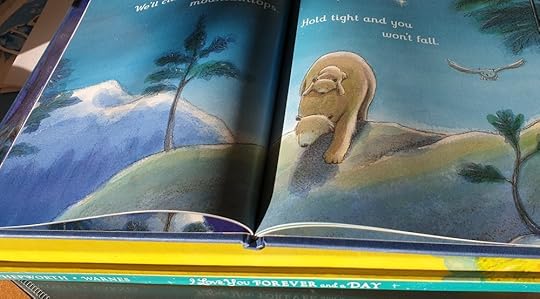
The newly published companion book, I Love You Forever and a Day (also written by Amelia Hepworth), also celebrates the love and laughter shared between parent and child. Again, there are tender and intimate scenes. But this time, the cool nighttime colours of Moon and Back are replaced by the warm colours of a summer’s day.
If I could imagine
a day just for you…
… The sun would be shining,
the sky would be blue.
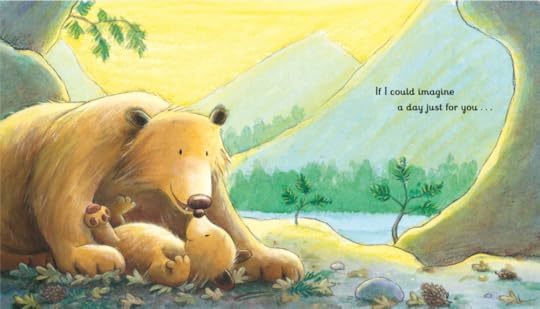
Little Bear sits on Big Bear’s shoulders as they cross the meadow, then paw-in-paw they hop from boulder to boulder across the river.
They walk through flowering meadows, past thundering waterfalls and then back to the bear cave as the sun sets and the stars begin to appear – just in time for bed.
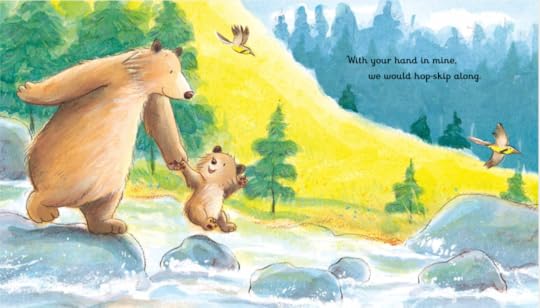
We’d snuggle together,
and gently I’d say
I love you my small one –
forever and a day.
Young children will identify with the bear cub’s exploration of the world and interactions with the big bear in both these soft, gentle stories. (With their nighttime endings, they lend themselves particularly well to bedtime readings.)
Yes – their message is simple.
But it is powerful and life-affirming.
You are loved.
A child who feels loved will grow into an empathic adult capable of giving and receiving love. In other words, an emotionally healthy individual.
Finding quality stories can be overwhelming. So stick with me.
I’ll guide you to some great picture books so you can choose with confidence and watch your child grow emotionally and relationally – ready to change the world!
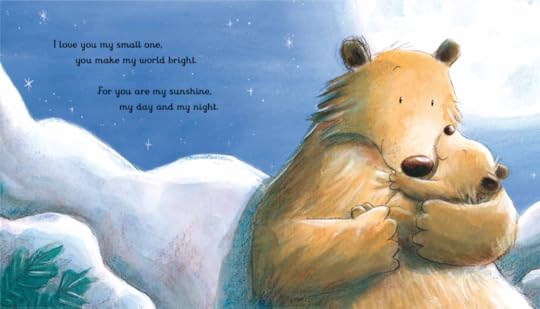 STORIES WORTH SHARINGI Love You Forever and a Day by Amelia Hepworth, illustrated by Tim WarnesGood to Read for:calming down before bedtimesnuggling up togetherexpressing love to your childText excerpts © 2015/2021 by Little Tiger Press | Illustrations © 2015/2021 by Tim WarnesCustomer image courtesy of @goldstage | Used by permissionGOOD TO READFor snuggling up with your child
STORIES WORTH SHARINGI Love You Forever and a Day by Amelia Hepworth, illustrated by Tim WarnesGood to Read for:calming down before bedtimesnuggling up togetherexpressing love to your childText excerpts © 2015/2021 by Little Tiger Press | Illustrations © 2015/2021 by Tim WarnesCustomer image courtesy of @goldstage | Used by permissionGOOD TO READFor snuggling up with your childI Love You to the Moon and Back by Amelia Hepworth & Tim Warnes
I Love You Forever and a Day by Amelia Hepworth & Tim Warnes
I Love You As Big As the World by David van Buren & Tim Warnes
BUY THE BOOKPowered by Bookshop.org
Supporting independent bookshops
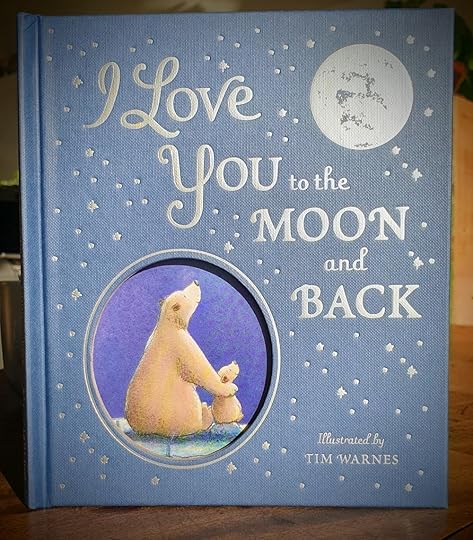 “Very sweet to share with small, snuggly, just out of the bath toddlers.” –
The Bookbag
“Fantastic book that tries to explain the unexplainable - the love a parent has for their child.”– Jon Nakapalau, Good Reads buy UK
“Very sweet to share with small, snuggly, just out of the bath toddlers.” –
The Bookbag
“Fantastic book that tries to explain the unexplainable - the love a parent has for their child.”– Jon Nakapalau, Good Reads buy UK Gift edition currently unavailable in the US.
For the board book edition, click here.
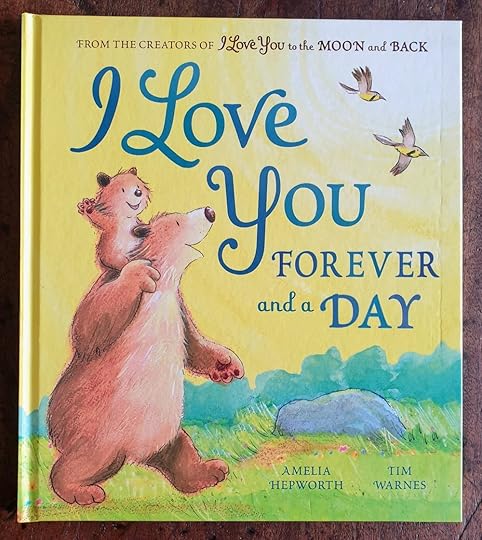 BUY UK BUY US * I EARN COMMISSION FROM THESE LINKS #AD/AFFRELATED ARTICLESSOURCESI Love You to the Moon and Back by Amelia Hepworth, illustrated by Tim Warnes (Little Tiger Press, 2015)I Love You Forever and a Day by Amelia Hepworth, illustrated by Tim Warnes (Little Tiger Press, 2021)
I Love You to the Moon and Back by Tim Warnes
(thebookbag.co.uk)
I Love You to the Moon and Back
(goodreads.com)© 2022 BY TIM WARNES(UNLESS OTHERWISE ATTRIBUTED)****USE OF THIRD PARTY COPYRIGHTED MATERIAL FALLS UNDER FAIR USE/FAIR DEALING PRACTICE.
BUY UK BUY US * I EARN COMMISSION FROM THESE LINKS #AD/AFFRELATED ARTICLESSOURCESI Love You to the Moon and Back by Amelia Hepworth, illustrated by Tim Warnes (Little Tiger Press, 2015)I Love You Forever and a Day by Amelia Hepworth, illustrated by Tim Warnes (Little Tiger Press, 2021)
I Love You to the Moon and Back by Tim Warnes
(thebookbag.co.uk)
I Love You to the Moon and Back
(goodreads.com)© 2022 BY TIM WARNES(UNLESS OTHERWISE ATTRIBUTED)****USE OF THIRD PARTY COPYRIGHTED MATERIAL FALLS UNDER FAIR USE/FAIR DEALING PRACTICE.
December 17, 2021
The Snowman
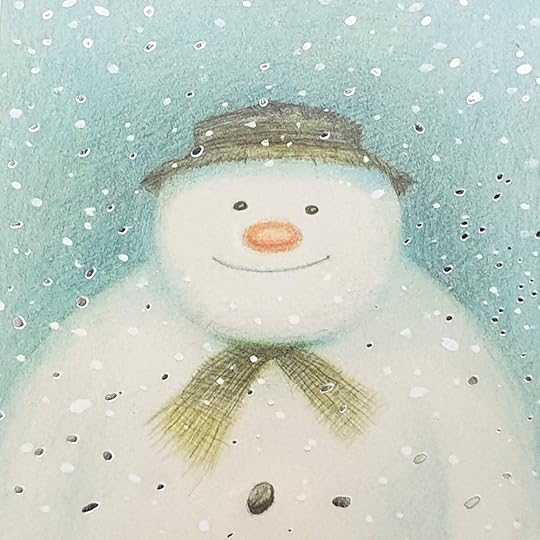 The Snowman by Raymond Briggs(Hamish Hamilton, 1978)Good to Read for:Winter magicencouraging storytelling skillscreating calmFew picture books evoke Christmas more than the timeless classic, The Snowman by Raymond Briggs (Hamish Hamilton, 1978).
The Snowman by Raymond Briggs(Hamish Hamilton, 1978)Good to Read for:Winter magicencouraging storytelling skillscreating calmFew picture books evoke Christmas more than the timeless classic, The Snowman by Raymond Briggs (Hamish Hamilton, 1978). Which is funny. Because the picture book (unlike the animated short film) doesn’t reference Christmas at all. There’s no trip to the North Pole. No Father Christmas. Not even a Christmas tree!
The story was inspired by the heaviest snow Briggs had ever seen. “Snow had fallen steadily all night long,” he recalls, “and in the morning I woke in a room filled with light and silence, the whole world seemed to be held in a dream-like stillness. It was a magical day… and it was on that day I made The Snowman.”
Briggs captures that magical day in a story told entirely through pictures. Lots and lots of them, working together sequentially in a style once regarded as ‘comic’ format, now elevated to the ranks of ‘graphic novel.’ (In a BBC Newsnight interview, he admits to disliking the term. “But [it] makes it sound posher which sells more, I suppose.”)
Believe it or not, wordless picture books are great for your child. They empower pre-readers (i.e. Children who are unable to read words), allowing them to step into the role of storyteller. Because if there are no words to fluff, then they can’t get it wrong! (I write more about the power of silent picture books in my reviews of Fox’s Garden and Hike.)
I remember sharing The Snowman with my kids when they were young. It was a very different experience to reading a picture book with words. It was calming and created a peaceful atmosphere (great for over-excited kids!). It somehow slowed everything down as we moved from panel to panel, searching the pictures for meaning and narrative (rather than breezing through a written story). You can sense that ‘dream-like stillness’ which enchanted Briggs on that snowy morning. In other words (to quote Posy Simmonds), The Snowman is “as quiet as when it snows.”
Even when Briggs shows how restless the boy feels at bedtime (knowing that his snowman – and all that wonderful snow! – is outside), it feels subdued. A small bedside clock shows the passing of time as the boy tosses and turns, unable to get the snowman off his mind. Finally, at 1am, he puts on his dressing gown, creeps downstairs and opens the backdoor – only to discover the Snowman, fully alive and tipping his hat in greeting. I still find that a magical moment!
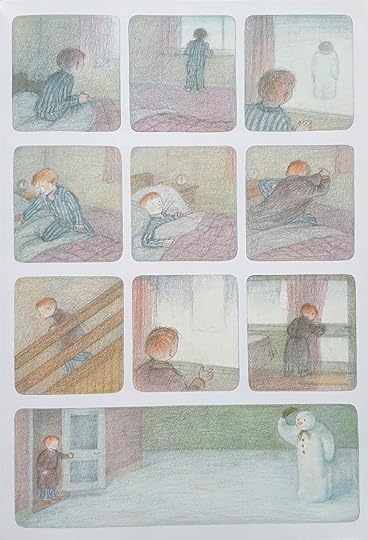
The boy invites his new friend inside. The Snowman enjoys exploring (I especially like his fascination with switching lights on and off!), and they fool around together.
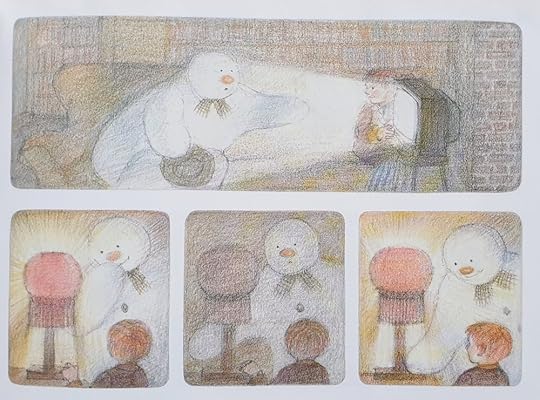
The Snowman is a great book for inspiring creativity and getting your little ones to tell their own tales. Prompt them with questions like, What might a snowman do in our house? What dangers will he need to watch out for?
(Speaking of which – I could never figure out why the painting of van Gogh’s Sunflowers makes the Snowman so sad. But it just occurred to me – it’s because they represent the ultimate heat source: the sun!)
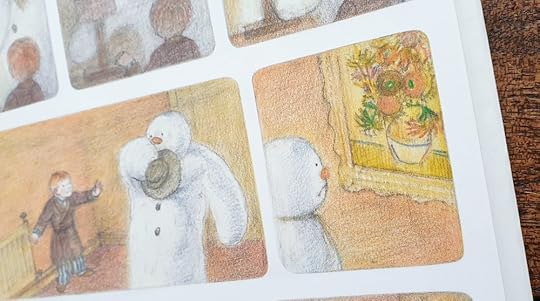
The Snowman takes some time out to relax in the chest freezer (I suspect a publisher would veto that scenario now), after which the new friends sit down to a candlelit supper.
[image error]But everyone knows: a house is no place for a snowman. So they go outside (Briggs contrasts the warmth of home with the wintry landscape outside beautifully) – and that’s where the magic really begins.
Taking the boys hand, the Snowman runs down the garden and takes off, flying up into the night sky.
[image error]After pages of small, panelled pictures, I love how Briggs gives us two big double spreads. They help emphasise the open expanse of the landscape and offer an extended moment to pause and relish the magic.
One snowman, one boy. Flying hand in hand over the snowy Sussex landscape.
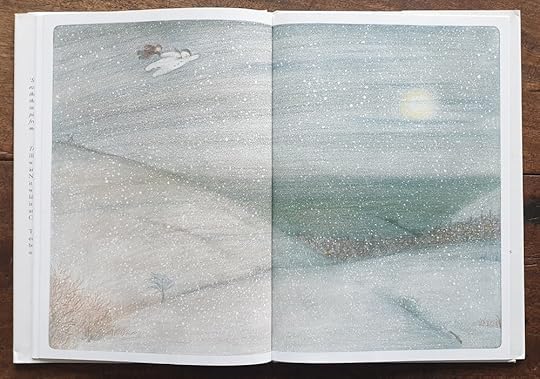
(The Snowman was inspired by that snowy morning at Briggs’s home in Westmeston, Sussex (UK). So it’s appropriate that the Snowman and the boy fly along the coast to Brighton, where they soar over the exotic-looking Royal Pavilion before landing on the Palace Pier.)
[image error]As they look out at sea, the first splash of colour on the horizon signals daybreak. The Snowman, visibly troubled, once again takes the boys hand. It’s time to fly home.
Because like in Cinderella, once the clock chimes a particular hour, the magic will end.
Back in the garden, the friends hug. It is a sad moment, and you sense how reluctant they are to say farewell. Finally, after many backward glances, the boy goes back to bed, fitfully sleeping until the morning.
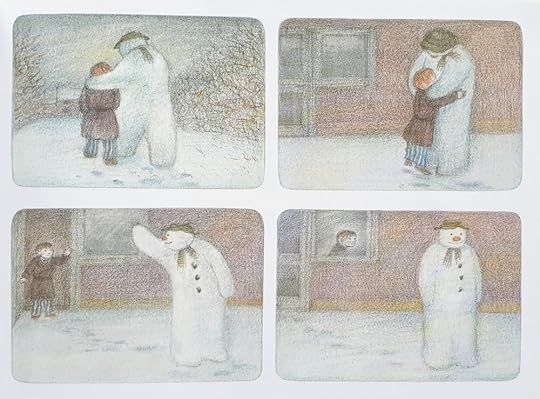
The official website sums up The Snowman rather nicely as a ‘timeless and magical tale [that] tells a story of imagination and friendship as well as love and loss.’
And it’s that combination – of love and loss – that make The Snowman so poignant and bittersweet. Many adults object to the inevitable melting away (effectively, the death of) the Snowman at the end of the book.
Seeing the boy rush downstairs, past his parents at the breakfast table – to discover what’s left of his friend -comes as quite a shock, even now. A hat, a scarf and some lumps of coal perched on a small mound of snow.
Trinkets left at a freshly dug grave.
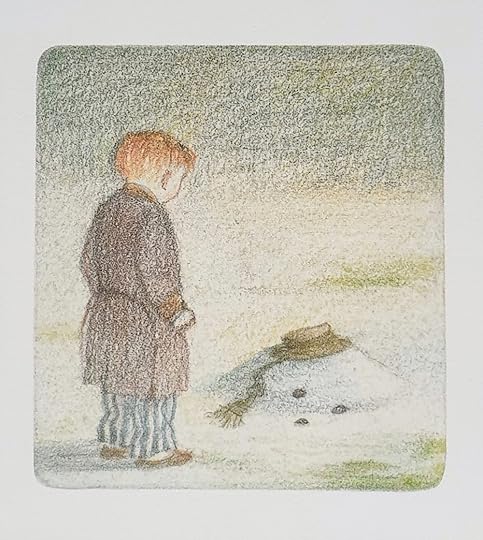
But that was the whole point. Briggs never intended The Snowman to be a jolly Christmas story. (Those elements were introduced in the animated adaptation that is so ingrained in our psyche.) He intended it to be about death all along.
“I don’t have happy endings,” Briggs told The Radio Times. “I create what seems natural and inevitable. The Snowman melts, my parents died, animals die, flowers die. Everything does. There’s nothing particularly gloomy about it; it’s a fact of life.”
Personally, I think the safe confines of a picture book is just the place to initiate such difficult conversations. Briggs is right. Sooner or later, a child will experience death – be it of a loved friend or family member, pet or maybe something the cat drags in. And they probably feel a lot less uncomfortable about it than us adults do.
On the other hand, many kids will take it at face value.
Snow comes.
Snow goes.
Seasons change.
Life goes on.
Here in the UK, it rarely snows at Christmas. But at least we can depend on Channel 4 to broadcast The Snowman. It has all the quiet magic – and sad ending – of the picture book. And as an added bonus, it comes complete with Christmas trimmings.
STORIES WORTH SHARINGThe Snowman by Raymond Briggs(Hamish Hamilton, 1978)Good to Read for:Winter magicencouraging storytelling skillsdeveloping visual literacyIllustrations © 1978 by Raymond BriggsGOOD TO READWordless Picture booksClown by Quentin Blake
The Snowman by Raymond Briggs
Fox’s Garden by Princesse Camcam
Hike by Pete Oswald
The Chicken Thief by Béatrice Rodriguez
(Almost) wordless picture booksHug by Jez Alborough
Banana by Ed Vere
BUY THE BOOKPowered by Bookshop.org
Supporting independent bookshops
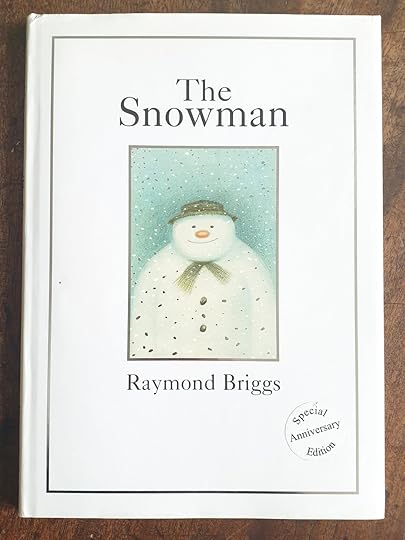
“As quiet as when it snows.”
– Posy Simmonds“Extraordinary and atmospheric.”
– Booktrust Buy UK buy us * I EARN COMMISSION FROM THESE LINKS #AD/AFFRELATED ARTICLESSOURCES Raymond Briggs Speaks About His Most Popular Books (Rowan Jones, 18 January 2018) Why I'd like to be a proper author (Raymond Briggs, The Guardian, 2 November 2002) The Snowman (thesnowman.com) Raymond Briggs: Snowmen, Bogeymen & Milkmen review – a timely look at an eccentric life (Tim Dowling, The Guardian, 31 December 2018) Interview with Raymond Briggs (Emma Chaplain, 9 August 2012) The surprising stories behind your favourite children's Christmas classics (Alice Vincent, penguin.co.uk, 17 December 2021)© 2021 BY TIM WARNES(UNLESS OTHERWISE ATTRIBUTED)****USE OF THIRD PARTY COPYRIGHTED MATERIAL FALLS UNDER FAIR USE/FAIR DEALING PRACTICE.December 10, 2021
I’ve Seen Santa!

My granddaughter and I smiled and enjoyed this story from the start to finish.— Rosa Cline, GoodReadsI’ve Seen Santa! by David Bedford, illustrated by Tim Warnes(Little Tiger Press, 2005)Good to Read for:some Christmas magicfeeling cosysharing a laugh with your kidsMy ex-wife and I never ‘did’ Santa with our kids. (We thought it might undermine the true (and arguably equally far fetched) Christmas story about the birth of Jesus.)
However, the boys didn’t miss out on any of the fun. Like most families, we still put out Christmas stockings for Father Christmas’s annual visit – except we played the game together (and shared the inside knowledge).
It’s ironic then that, over the years, I’ve illustrated a number of picture books featuring Santa (including a whole range (Shhh! et al by Julie Sykes) for Little Tiger Press. And yes, I did feel somewhat conflicted for perpetuating the myth!). Today I’m sharing my favourite of those: I’ve Seen Santa! By David Bedford (Little Tiger Press, 2005) described by Through The Looking Glass Reviews as ‘the perfect title to read on Christmas Eve when children are excited and are having a hard time settling down for the night.’
One of the joys of I’ve Seen Santa! is that it captures the excitement of Christmas Eve. On the title page (before the written story even begins), Mummy Bear is busy laying the table cloth while Big Bear and Little Bear unbox the decorations.

Eagle-eyed readers will notice a little grey mouse, peeping from a hole in the side of the cardboard box. Look closely, and you’ll find him hiding on each page. “I love how the illustrator incorporated a little mouse in each set of pictures,” writes Anna on GoodReads. “I love when artists put little secrets in their work. It was like a fun little secret game of "find the little mouse" while reading the story.”
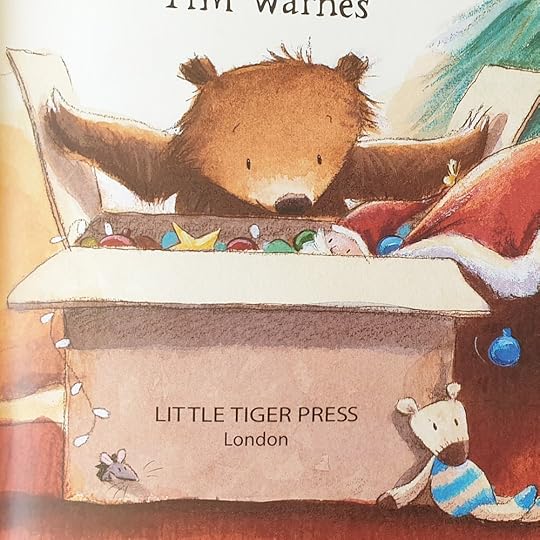
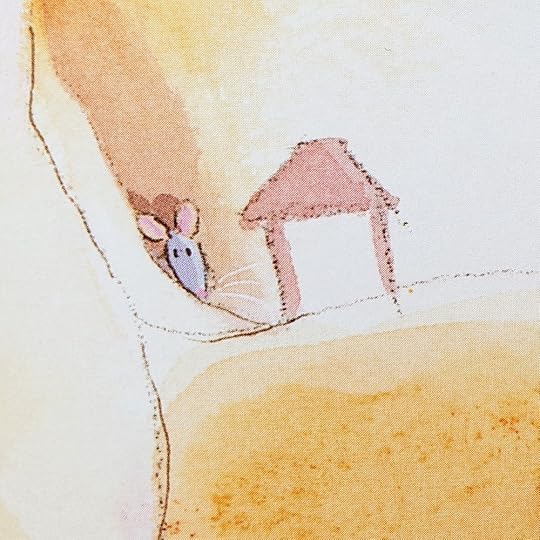
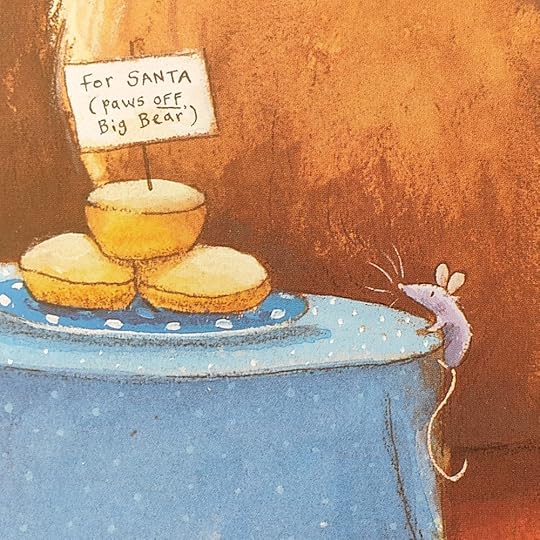
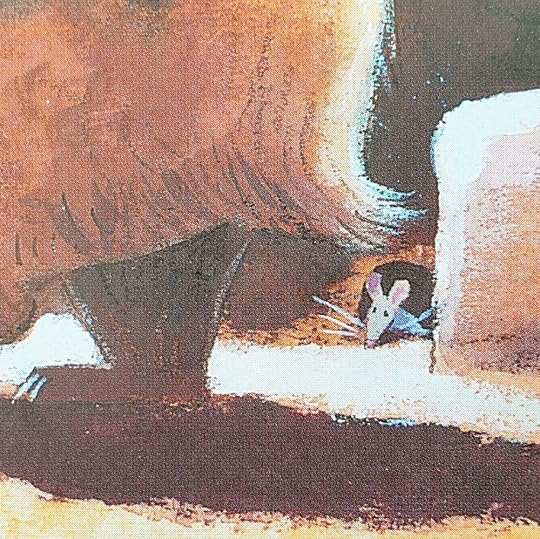
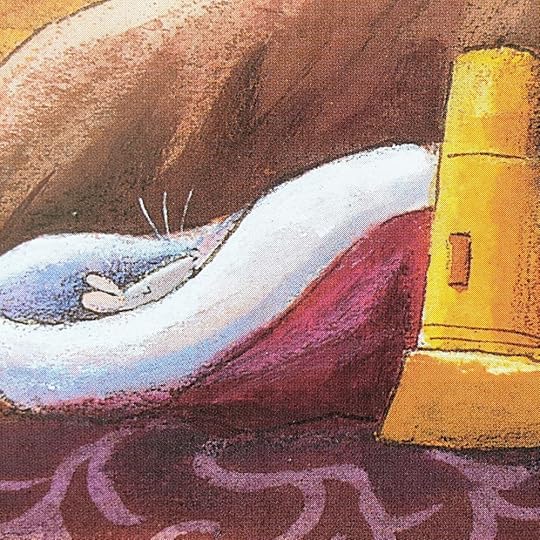
It’s a device I’ve used a few times in my books (including that earlier series of Santa books by Julie Sykes). It engages curious kids – a little trick I learnt from Richard Scarry’s Cars and Trucks and Things That Go (Gold bug is fiendishly hard to find) and illustrator Andrew Cartwright (who hid a yellow rubber duck in his work for Usborne Books).
Here’s how the story begins:
It was Christmas Eve and Little Bear was looking forward to seeing Santa.
“Is Santa as big as you?” he asked Big Bear.
“Nearly,” said Big Bear, proudly.
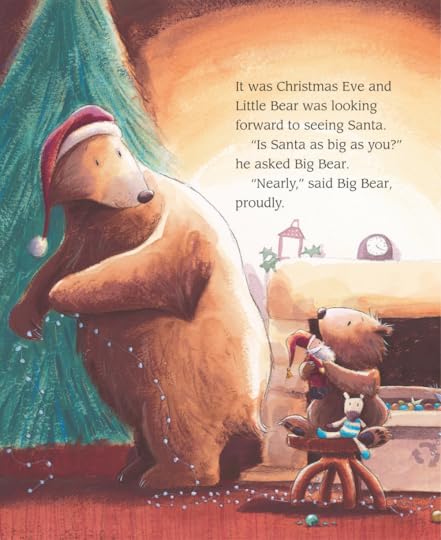
Bedford sets up the characters beautifully: From the off, Little Bear is excited and full of questions, which Big Bear answers with unswerving confidence! When asked if Santa will fit down their chimney, Big Bear replies, “Of course he will! “ Then goes outside and climbs into the chimney to demonstrate his authority.
CRASH!
“See?” said Big Bear from a cloud of soot.
“Santa will get in, no problem!”
Enter Mummy Bear, carrying a plate of mince pies and a glass of milk for Santa. She’s the practical one: “Santa won’t come if he sees this mess!”, she warns. Then she reassures Little Bear that Santa will come just as soon as he goes to sleep.
[image error]But of course, Little Bear doesn’t want to go to sleep. It’s Christmas Eve – he wants to see Santa! (Whatever was Mummy Bear thinking.)
Bedford ’s text is funny, clever and relatable for both adult and child. ‘[He] masterfully walks the fine line between a parent's vs. child's version of Christmas Eve, ‘ writes Lesley Dahlseng on Good Reads.
Little Bear listens as Mummy and Big Bear go to bed. And then…
GLUG,GLUG, GLUG, GLUG!
What was that noise?
Someone was downstairs!
Someone big was sitting in the fireplace.
“Yes!” whispered Little Bear. “It’s Santa! I’ve seen Santa!”
Instead, Little Bear finds Big Bear, caught red handed drinking the milk that’s been left out for Santa.
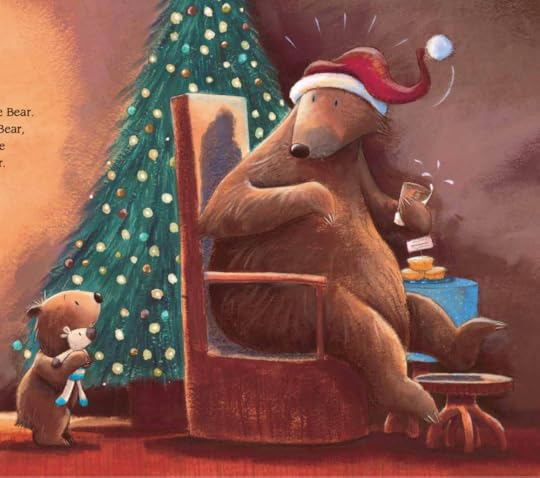
“I only wanted a sip,” said Big Bear, “before I go to sleep.” He took Little Bear’s hand. “Come on, Little Bear. Let’s go to bed.”
Little Bear dozes off, but is woken by a loud munching. Could it be Santa?
Nope! It’s Big Bear again!
“If Santa’s as greedy as you,” said Mummy Bear, coming downstairs,”he’ll be too big and he WILL get stuck in the chimney! Now go to bed and go to sleep – both of you!”

Now Little Bear is too worried to sleep in case Santa eats too many mince pies and gets stuck in the chimney! He wakes up Big Bear with a plan:
“Let’s keep watch to make sure [Santa’s] OK,” said Little Bear. “We can hide so he won’t see us.”
The next part still makes me smile! Big Bear and Little Bear are huddled up under a blanket (modeled on my son’s). From their hiding place beside the Christmas tree, they hear something. Someone is putting presents into their stockings on the mantle piece. “It must be Santa this time!” whispers Little Bear. ‘Big Bear turned on his torch to see…’
A well-timed page turn in a picture book is a beautiful thing. And this is a favourite of mine as it has such an element of surprise…
Because it’s the straight-laced Mummy Bear’s turn to get caught red-handed.
“What are YOU doing?” said Big Bear.
“I’m giving you both a present from me,” said Mummy Bear. “Just in case Santa is a tiny bit late. ...”

Well played, Mummy Bear!
(It’s a close-call that many parents will chuckle at. And as Publishers Weekly commented, ‘[a]dults may welcome this gentle explanation of Santa's parental "helpers.”’
But importantly, it doesn’t spoil the magic, and Little Bear is unphased.)
Mummy Bear then skillfully deflects the attention onto the others and asks, “What are YOU doing?”
“We’re not going to bed,” said Big Bear.
“We’re going to see Santa!” squealed Little Bear.
Mummy Bear laughed.
“Make room for me then,” she said. “We’ll ALL see Santa.”
And so the three bears snuggle up to keep Santa Watch throughout the night. But of course, they all fall fast asleep.
“I loved this sweet and silly tale,” writes Melki on GoodReads. “Tim Warnes’ beautiful artwork makes this one special, and made me add an extra star to my rating.” It’s 16 years since I illustrated I’ve Seen Santa! and I have to say, I am still pleased with my work. I was careful to add small details (for example, the multitude of lanterns, the patched blankets and threadbare rug) which would collectively create a warm, cosy atmosphere and build on the excitement of Bedford’s text. Overall, I agree with Melki’s review, which continues:
A terrific tale to read to your own little cubs in anticipation of the big event. - Melki, GoodReads.
Finally, children are rewarded with the much anticipated, magical Christmas moment.
Santa arrives at the bears’ home!
With his work done (the stockings bulge with presents – there’s even a tiny present beside the sleping mouse!), Santa sits down to enjoy what’s left of his mince pies and milk.
While the bears, none the wiser, sleep on…
 STORIES WORTH SHARING: I’ve Seen Santa! by David Bedford, illustrated by Tim Warnes(Little Tiger Press, 2005)Good to Read for:some Christmas magicfeeling cosysharing a laugh with your kidsText excerpts © 2005 by David Bedford | Illustrations © 2005 by Tim WarnesGOOD TO READMagical picture books featuring Santa
STORIES WORTH SHARING: I’ve Seen Santa! by David Bedford, illustrated by Tim Warnes(Little Tiger Press, 2005)Good to Read for:some Christmas magicfeeling cosysharing a laugh with your kidsText excerpts © 2005 by David Bedford | Illustrations © 2005 by Tim WarnesGOOD TO READMagical picture books featuring SantaI’ve Seen Santa! By David Bedford, ill. by Tim Warnes
Father Christmas by Raymond Briggs
Harvey Slumfenburger’s Christmas Present by John Burningham
Toot and Puddle: I’ll Be Home For Christmas by Holly Hobbie
A Message for Santa by Hiawyn Oram, ill. by Tony Ross
Bear Stays Up for Christmas by Karma Wilson, ill. by Jane Chapman
BUY THE BOOKPowered by Bookshop.org
Supporting independent bookshops
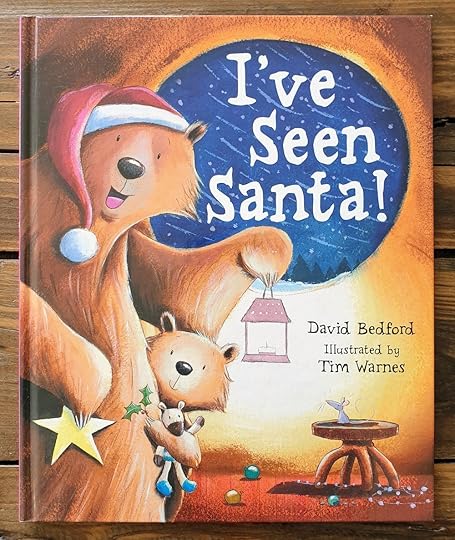
“One of my toddler's favorite holiday books.”
- Lindsey, GoodReads“The perfect title to read on Christmas Eve when children are excited and [have] a hard time settling down for the night.”
– Through The Looking Glass Children’s Book Reviews buy UK buy US * I EARN COMMISSION FROM THESE LINKS #AD/AFFRELATED ARTICLESSOURCES I’ve Seen Santa (GoodReads) I’ve Seen Santa (Publisher’s Weekly) I’ve Seen Santa (Marya Jansen-Gruber, Through the Looking Glass Children's Book Reviews)© 2021 BY TIM WARNES(UNLESS OTHERWISE ATTRIBUTED)****USE OF THIRD PARTY COPYRIGHTED MATERIAL FALLS UNDER FAIR USE/FAIR DEALING PRACTICE.December 3, 2021
Refuge: an important retelling of the Nativity
Goodnight Manger takes a refreshing look at just how noisy and chaotic the traditional tableaux might have been. Meanwhile, in Jesus’ Christmas Party, the focus is on the grumpy innkeeper who is desperate for sleep! Today’s somewhat quieter recommendation looks at the Christmas story from yet another angle – as witnessed by the little donkey: Refuge by Anne Booth, illustrated by Sam Usher (Nosy Crow, 2015)
Booth’s quiet retelling of the Christmas story is faithful to the Biblical account. Yes, it downplays the divine (there are no angels or halos). Instead, Booth focuses on the humanity of the event and, in doing so, brings home truth that is so easily overlooked amid the spectacular drama of angelic hosts and the bright, guiding star. Because when all the trimmings are removed, and you get down to basics, what we’re left with is a vulnerable refugee family. And that’s what this book shines its light on.
The story, narrated by the donkey, begins:
The man led me, and I carried the woman all the way to Bethlehem…
Then promptly jumps to where many nativity stories end:
And then the baby was born.
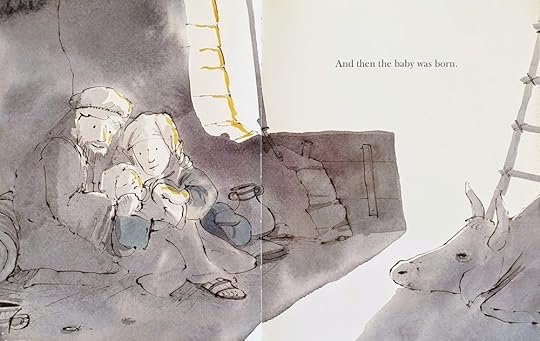
No fuss.
No heraldic choir of angels.
It’s quiet and intimate – and human.
You can almost hear the rustle of the donkey and the lowing ox.
(Usher’s use of negative space is worth praising – I love how he leaves the white of the paper to convey the bright starlight flooding into the stable.)
Booth’s descriptions of the newborn baby are suitably tender and will resonate with parents (and older siblings) everywhere:
[The woman] smelt his sweet baby breath, and felt his soft, warm baby skin…as he sleepily nuzzled her neck.
Then descriptions remind the reader of the humanity of the scene. Mary, Joseph – and Jesus – were fully human.
They didn’t glow in the dark with holiness.
They huddled close for warmth.
The shepherds come from out of the darkness (shown only as shadowy, indistinct figures), followed by the kings.
When the last king left, the scent of frankincense lingering in the air, we all slept and the man had a dream.
Big chunks of detail have been omitted from Booth’s version of the Nativity. But not this part: Joseph’s dream. It’s usually glossed over, even in church services. Refuge (appropriately) summarises the supernatural encounter as ‘[a] dream of danger’ – and it’s crucial to what happens next.
Here’s the Biblical account:
[A]n angel of the Lord appeared to Joseph in a dream and said, “Get up! Take the Child and His mother and flee to Egypt, and remain there until I tell you; for Herod intends to search for the Child in order to destroy Him.”
…[Herod] sent [soldiers] and put to death all the male children in Bethlehem…who were two years old and under… Then what had been spoken through Jeremiah the prophet was fulfilled:
“A voice was heard in Ramah,
Weeping and great mourning,
Rachel weeping for her children;
She refused to be comforted,
Because they were no more.”’
– Matthew 213-18 (AMP)
The man, the woman and the donkey (now carrying his ‘precious load’) must begin their journey once more. Under cover of night, they flee Bethlehem (and the murderous wrath of King Herod) and head to Egypt where they hope to find ‘the kindness of strangers. Again.’
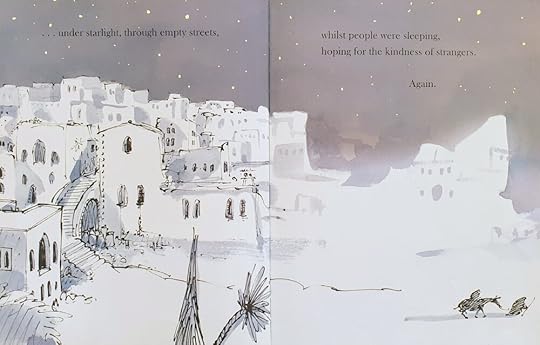
Travelling through a series of wide vistas, they talk ‘about journeys and dreams and warnings, and the love of a baby, and the kindness of strangers.’ They are small and vulnerable – but hope is conveyed through both words and pictures. Passing shepherds in the fields, there are ‘whispered blessings… the clasp of rough hands, and the love of warm hearts.’
The text is minimal and powerful. Reference to any detail of the danger the family faced is omitted. Still, the reality of their plight is not underplayed. That said, there’s a thread of hope that runs throughout the story.
And when we rested,
And they were frightened,
They took hope from each other,
And from the baby’s tiny first smile.
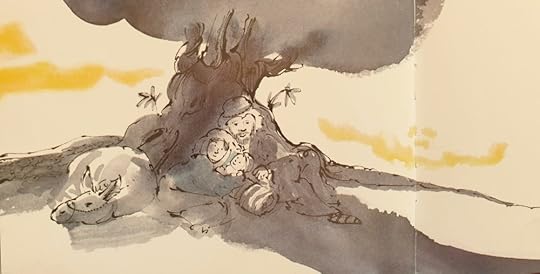
Young children will read and listen to this story. Therefore, explains Booth, “It must have hope. To be human and not to have hope is to be in hell.”
The hope conveyed through the text is enhanced and emphasised by Usher’s illustrations. The young family’s escape through empty, shadowy streets is illustrated in quiet, grey tones. Here and there are glimmers of hope – hints and highlights of warm yellow and orange, which become more prominent as their journey progresses.
The story concludes with the family entering Egypt. As they find welcome and a safe refuge in the home of strangers, warm, golden yellow floods the page – and holds all the promise of a new dawn.
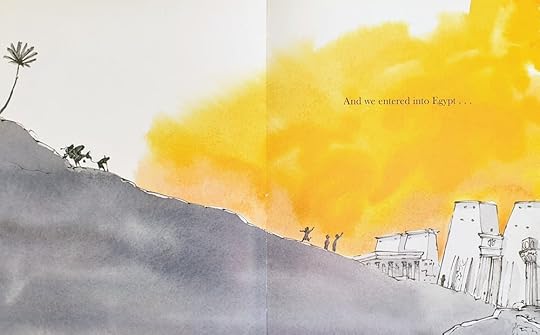 ‘[Refuge] is a book with timeless crossover appeal and a message that couldn’t be more relevant,’ wrote the story’s publisher, Nosy Crow, when it was first published in 2015.
‘[Refuge] is a book with timeless crossover appeal and a message that couldn’t be more relevant,’ wrote the story’s publisher, Nosy Crow, when it was first published in 2015. Like Nicola Davies’s The Day War Came, Refuge was created in response to the Syrian and Iraqui refugee crisis.
An inappropriate topic for a child’s picture book?
I guess that depends on how much you value picture books and their significance in a child’s life. Is their sole aim is to entertain and titillate – or if their power is more profound? “[Refuge is an] excellent way to help children make sense of what they are seeing on news bulletins every day,” wrote The Times. I couldn’t agree more, (but I would also add that it’s an excellent tool for developing empathy).
For younger children who may still be sheltered from the realities of life, Refuge is a gently told version of the Nativity (without all the bells and whistles).
For older kids, Refuge (as The Telegraph points out) makes the connection between the familiar Nativity story and today’s refugees ‘fleeing their own King Herod with delicacy and beauty.’
Quality picture books such as Refuge play a crucial role in nurturing our kids. And if we continue developing their sense of empathy, then who knows? Maybe the future will be brighter for refugees and asylum seekers. (After all, our children will grow up to become the decision-makers of tomorrow.)
And maybe displaced children will become a thing of the past.
[image error] STORIES WORTH SHARING: Refuge by Anne Booth, illustrated by Sam Usher(Nosy Crow, 2015)Good to Read for:its message of hopea realistic account of the Christmas storyunderstanding the plight of refugeesText excerpts © 2015 by Anne Booth | Illustrations © 2015 by Sam Usher GOOD TO READPicture books about refugees and asylum seekers• The Day War Came by Nicola Davies and Rebecca Cobb
The Suitcase by Chris Naylor-Ballesteros
King of the Sky by Nicola Davies & Laura Carling
BUY THE BOOKPowered by Bookshop.org
Supporting independent bookshops

“A book with timeless crossover appeal and a message that couldn’t be more relevant.”
–NOSY CROW“A book to share with a lump in your throat and an ache in your heart”
– CHRIS RIDDELL, CHILDREN’S LAUREATE Buy UK BUY US * I EARN COMMISSION FROM THESE LINKS #AD/AFFRELATED ARTICLESSOURCESRefuge by Anne Booth, illustrated by Sam Usher (Nosy Crow, 2015)The Christmas story retold: Refuge – In Pictures (Anne Booth, The Guardian, 13 December 2015)Amplified Bible © The Lockman Foundation© 2021 BY TIM WARNES(UNLESS OTHERWISE ATTRIBUTED)****USE OF THIRD PARTY COPYRIGHTED MATERIAL FALLS UNDER FAIR USE/FAIR DEALING PRACTICE.
November 26, 2021
Thankful for a northern night

From Once Upon Northern Night by
Once Upon a Northern Night by Jean E. Pendziwol, illustrated by Isabelle Arsenault(Walker Books 2016)Good to Read for:its sense of magic and wondercreating calm at bedtimeintroducing children to poetryI want to recommend a picture book this Thanksgiving week that carries a deep feeling of love and gratitude. There’s plenty to choose from, especially those themed around friendship and acceptance. But I decided to go bigger than that – thankfulness for the world around us!The intriguingly titled Once Upon A Northern Night by Jean E. Pendziwol, illustrated by Isabelle Arsenault (Walker Books, 2016 (first published by Groundwood Books, 2013)), promises something special – and it is!
Pendziwol was inspired by animal tracks in the morning snow (scurryings and scamperings left overnight – but by whom?). The resulting story is presented as a poem, celebrated by Kirkus Reviews as ‘a beautiful, lyrical celebration’ of a northern night and the natural rhythms of the creatures that inhabit it. It captures the magic of winter for me in the same way as Susan Cooper’s The Dark Is Rising or the picture book, Bear and Wolf. (Find further recommendations of magical winter-themed picture books at the end of the article.)
The story begins with a child asleep, safe and sound in their bed.

‘Once upon a northern night / while you lay sleeping, / wrapped in a downy blanket, / I painted you a picture.’
First one, then another snowflake falls:
Soon
the night sky filled with
sparkling specks of white,
crowding
and floating,
tumbling down to the welcoming
ground
until the earth was
wrapped in a downy blanket,
just like you.
The story’s first line (and title) – Once upon a northern night – is repeated throughout. This repetition is reassuring and helps create the feeling of a gentle lullaby. At the same time, the descriptions of nocturnal life and the snow-covered forest conjure delightful images. For example, deer ‘nuzzled the sleeping garden / with memories of summer’. Snow drifts in mounds ‘like vanilla ice cream’, and a great grey owl leaves ‘a feathery sketch / of his passing / in the snow.’
Arsenault’s beautiful illustrations, illustrated predominantly in black and white tones, have a soft, retro feel. They enhance the atmosphere of the text and bring to life the quiet dramas playing out in the dark. Her subtle use of colour fits a nighttime story and is limited to one colour per spread. For example, the owl’s yellow beak and eyes, the burnt orange of a fox and green pine needles (held out like ‘prickly hands to catch the falling flakes’.)

Finally, it’s the turn of the northern lights themselves: ‘melodies of/green and/pink and/orange/[that] sang across the sky.’
I tried to capture them
but they were much too nimble,
and only their rhythm reached you,
deep in slumber,
rising and falling
with each sweet,
peaceful breath.
So beautiful.
There’s much to love about Northern Night, which already feels like a classic. But one review questioned the child appeal of the text (‘I think the poetry may be lost on younger children….I doubt the words would make much sense to younger children’). I think their concern is unfounded because:
Stretching children’s vocabulary engages their curiosity. (They’ll ask questions if they want to know more.)
Pendziwol’s lilting, sing-song text will have the same effect as a lullaby on little ones. (In the same way, I can enjoy Björk’s Vokuro, despite not understanding a word of Icelandic.)
Children are never too young for poetry.
The story draws to a close by coming full circle. Night passes, morning comes and we are treated to a colour spread that feels light and fresh.

The first verse is repeated once more, then concludes:
And then
I had the moon gently kiss you
And the wind whisper…
I love you.
‘If ever there was a book to capture the sensation one has as a young child of being tucked in at night ... feeling so comforted, safe and truly loved,’ says Inis Magazine, ‘this is it.’
But it begs the question: Who is this mysterious narrator who watches over all and can command the moon and wind?
From my perspective as a Christian, this poem reads like a love song from God. It feels like Papa is whispering to me, His precious child, sharing the secrets of the night. That’s why I find it so deeply moving and comforting.
(So perhaps I did pick a Thanksgiving book around the theme of friendship and acceptance after all.)
STORIES WORTH SHARINGOnce Upon a Northern Night by Jean E. Pendziwol, illustrated by Isabelle ArsenaultText © 2013 by Jean E. Pendziwol | Illustrations © 2013 by Isabelle ArsenaultGood to Read for:its sense of magic and wondercreating calm at bedtimeintroducing children to poetryGOOD TO READMagical, winter-themed picture booksThe Snowman by Raymond Briggs
Fox’s Garden by Princesse Camcam
The Storm Whale in Winter by Benji Davis
Toot & Puddle: I’ll Be Home For Christmas by Holly Hobbie
Little Honey Bear and the Smiley Moon by Gillian Lobel & Tim Warnes
Bear and Wolf by Daniel Salmeiri
Bear Stays Up For Christmas by Karma Wilson & Jane Chapman
BUY THE BOOKPowered by Bookshop.org
Supporting independent bookshops

“A reverent ode to the magic and wonder of an icy winter night.”
– PUBLISHERS WEEKLY“Destined to join the ranks of winter-themed classics to be reached for year after year.”
— QUILL & QUIRE buy UK BUY US * I EARN COMMISSION FROM THESE LINKS #AD/AFFRelated ArticlesSOURCESOnce Upon a Northern Night by Jean E. Pendziwol, illustrated by Isabelle Arsenault (Walker Books, 2016) Book Review: Once Upon A Northern Night by Jean E. Pendziwol & Isabelle Arsenault (Kitty Cat Strawberry - Meow, 29 December 2019) Once Upon a Northern Night (House of Anansi) Jean Pendziwol: Once Upon a Northern Night (Jean E Pendziwol, youtube.com, 7 April 2020)© 2021 BY TIM WARNES(UNLESS OTHERWISE ATTRIBUTED)****USE OF THIRD PARTY COPYRIGHTED MATERIAL FALLS UNDER FAIR USE/FAIR DEALING PRACTICE.November 19, 2021
Challenging racial bias with a polar bear hug!
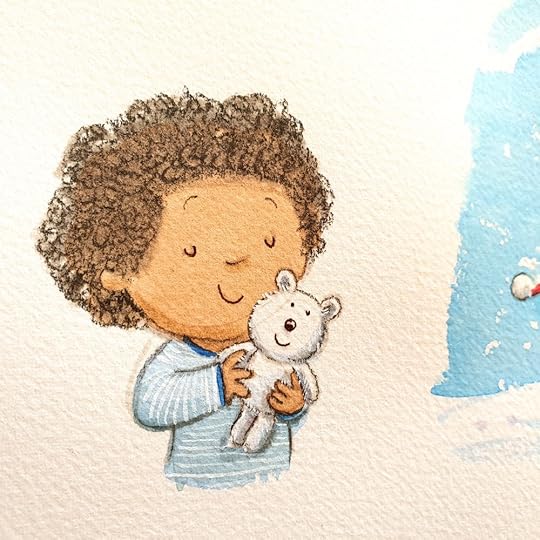
Development sketch for I’m Going To Give You a Polar Bear Hug! by Caroline B. Cooney, illustrated by Tim Warnes (Zonderkidz, 2020) | Text © 2020 by Caroline B. Cooney | Illustrations © 2020 by Tim Warnes
I’m Going To Give You a Polar Bear Hug! by Caroline B. Cooney, illustrated by Tim Warnes(Zonderkidz, 2020)Good to Read for:playful interactionsnuggling up before beddiversifying your child’s bookshelfWhat makes a great picture book?Quality text that’s a pleasure to read aloud (and withstands repeated readings). Engaging illustrations that are representative of the text while adding extra narrative to engage young minds. Preferably something that encourages you and your child to snuggle up together and enjoy a moment of physical as well as emotional connection.
This week’s recommendation – I’m Going to Give You a Polar Bear Hug! by Caroline B. Cooney (illustrated by myself!) – ticks all those boxes! ‘A playful, charming story,’ writes librarian Amy Atzert (Somerset County Library, New Jersey ) ‘that encourages imagination and warms hearts.’

From I’m Going To Give You a Polar Bear Hug! by Caroline B. Cooney, illustrated by Tim Warnes (Zonderkidz, 2020) | Text © 2020 by Caroline B. Cooney | Illustrations © 2020 by Tim Warnes
I’m going to give you a polar bear hug…
A wintry, windy,
Play in the snow hug.
A shivery, quivery,
Forty below hug.
I’m Going to Give You a Polar Bear Hug! follows the highly successful I’m Going to Give You a Bear Hug! Like its predecessor, Polar Bear Hug! imagines all the cosy, warm hugs that kids love to receive – only this time on a cold and windy snowy day. (The first book, Bear Hug!, has apparently been read to over 100,000 children – resulting in at least that many hugs. If even vaguely accurate, that makes me – as someone who loves to hug – very happy!)
Polar Bear Hug! introduces young children to polar animals (including walrus, seal and reindeer). It celebrates not only hugs but the power of a child’s imagination. Because it becomes apparent from the illustrations that the animals in question are, in fact, a bunch of cuddly toys out for a snow ride in a cardboard box sledge. (In the first book, the hugs are all given by the boy’s mummy as she acts out different animal characters.)

From I’m Going To Give You a Polar Bear Hug! by Caroline B. Cooney, illustrated by Tim Warnes (Zonderkidz, 2020) | Text © 2020 by Caroline B. Cooney | Illustrations © 2020 by Tim Warnes
The polar bear theme runs through the illustrations, too: With the help of her dad, the girl togs up in a fluffy white base layer complete with hood and ears. (I refer to the child as a girl, but in fact, they are not assigned gender in the text.) She has a small, white teddy bear that joins her as she meets, greets and plays with the animals. (By dressing Dad in a white shirt, I hoped to suggest that he is the big polar bear.)

From I’m Going To Give You a Polar Bear Hug! by Caroline B. Cooney, illustrated by Tim Warnes (Zonderkidz, 2020) | Text © 2020 by Caroline B. Cooney | Illustrations © 2020 by Tim Warnes
These extra narratives that run throughout the story are fun to pick out and help develop your child’s ability to ‘read’ pictures (visual literacy) and stimulate imaginary play.
I’m going to give you a penguin hug.
A fishy grin,
Black and white spin,
Dance flipper-to-chin hug.

From I’m Going To Give You a Polar Bear Hug! by Caroline B. Cooney, illustrated by Tim Warnes (Zonderkidz, 2020) | Text © 2020 by Caroline B. Cooney | Illustrations © 2020 by Tim Warnes
It’s clear from reviews that readers enjoy the way Polar Bear Hug! engages their kids and encourages some cuddle time:
“Fun to read out loud…. younger children will love looking at the bright and cheerful illustrations and the rhyming language, whilst older children will appreciate the detail. … My son [aged three] says this is one of his favourite books”
– Christy, GoodReads
“We used this as a bedtime story and it worked well with final snuggles for the night.”
– Carla Johnson-Hicks, GoodReads
“The animal hugs … add gross motor play to a winter storytime with learners reenacting the seal stands, bunny hops, and cardinal flight of the protagonist’s vivid imagination.”
– Pennsylvania School Librarians Association
Reviews such as those assure me that Polar Bear Hug! was a worthwhile project (and that I did my job well!).
But more important for me was this review:
“I appreciate how children’s books, especially this picture book, represent the black community.”
– Reading_Tamishly, Goodreads
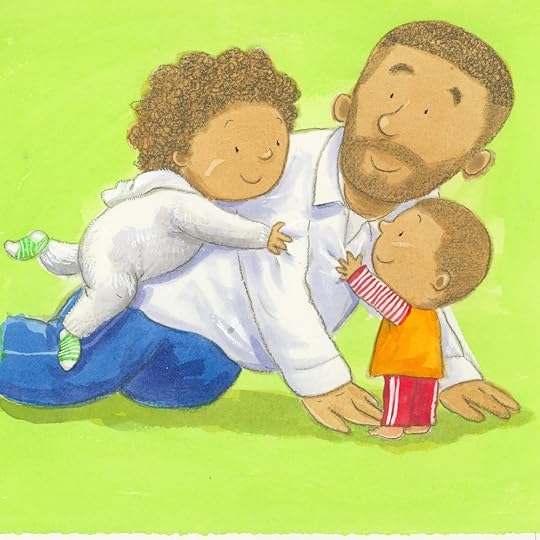
From I’m Going To Give You a Polar Bear Hug! by Caroline B. Cooney, illustrated by Tim Warnes (Zonderkidz, 2020) | Text © 2020 by Caroline B. Cooney | Illustrations © 2020 by Tim Warnes
In 2018, Jennifer Vanasco noted on Gothamist that ‘the tired trope that white children won’t read books about children of other colors continues to circulate.’(I heard this said back in the early 90s when discussing the outstanding So Much! by Trish Cooke and Helen Oxenbury with a publisher.)
I’m happy to say that the number of diverse picture books featuring kids of colour has increased significantly over the last few years. And yes – it was a very deliberate move on my part to depict a black family (and a kid with a big mop of Afro curls). I’m aware of the need for anti-racist stories showing kids of colour doing normal, everyday things (like hugging polar bears!). They create diversity without the issue of race being central to the stories themselves.
Children need access to diverse picture books because:
They cut across ‘the assumed superiority of Whites and the assumed inferiority of people of color.’
They promote direct and intentional discussion with young children about race and skin colour, which helps to ‘unravel and challenge the racist ideas that form in our kids’ minds’. (Children who discuss race with their parents show less racial bias than those who don’t.)
“If we shush our kids for asking about race, we are telling them that race is taboo and not something they can talk to you about,” says paediatrician Nia Heard-Garris. “Which means they’ll be left to fill in the blanks themselves in potentially prejudiced ways.”
Experts agree: it’s no longer enough to teach kids not to ‘see colour’. “In fact,” writes Alicia Cox Thomson on Today’s Parents, “it’s harmful.”
“To say, ‘I’m colorblind is to say ‘I have the privilege of never having to worry about color,’” says Ms Lythcott-Haims, a former corporate lawyer and Stanford dean. “Those of us who wear a skin of brown don’t have that luxury. The right approach is to recognize that humans come in innumerable varieties of color and hair texture and eye shape and noses and lips and height and weight. There are differences aplenty. The key is to teach our children that differences aren’t bad.”
- New York Times
Here are some facts from HealthyChildren.org to back all this up:
As early as 6 months, a baby’s brain can notice race-based differences.
By ages 2 to 4, children can internalise racial bias.
By age 12, many children become set in their beliefs.
(My earlier article, Using picture books to combat racism, explores this more.)
The onus is on parents to intentionally seek out diverse stories. They are great conversation starters! (See my favourite stories that depict black characters doing everyday things at the end of this article.) By sharing them with your child, you will challenge and decrease racial bias and improve cultural understanding as they ‘grow into race-conscious little humans’.
In other words – society needs you right now.
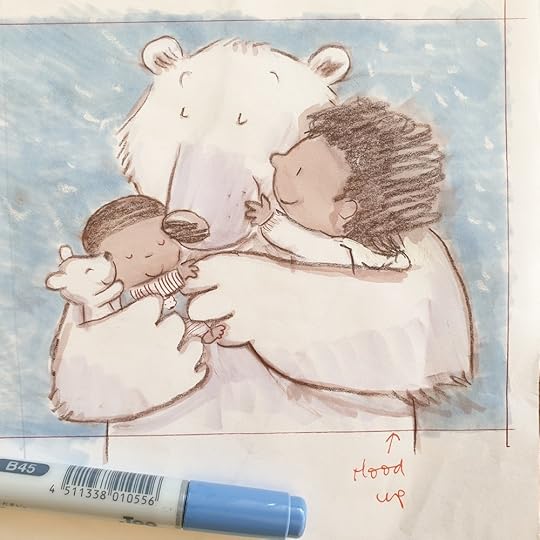
Development sketch for I’m Going To Give You a Polar Bear Hug! by Caroline B. Cooney, illustrated by Tim Warnes (Zonderkidz, 2020) | Text © 2020 by Caroline B. Cooney | Illustrations © 2020 by Tim Warnes
STORIES WORTH SHARINGI’m Going To Give You a Polar Bear Hug! by Caroline B. Cooney, illustrated by Tim WarnesGood to Read for:playful interactionsnuggling up before beddiversifying your child’s bookshelfGOOD TO READAnti-Racist Picture books to diversify your bookshelf
The New Small Person by Lauren Child
So Much! by Trish Cooke & Helen Oxenbury
I’m Going To Give You a Polar Bear Hug! by Caroline B. Cooney & Tim Warnes
We All Play by Julie Flett
Mr Scruff by Simon James
Leon & Bob by Simon James
The Snowy Day by Ezra Jack Keats
Julián Is A Mermaid by Jessica Love
Last Stop On Market Street by Matt de la Peña & Christian Robinson
BUY THE BOOKPowered by Bookshop.org
Supporting independent bookshops

“A perfect read-aloud choice.”
– Amy Atzert, Librarian
“Will capture the attention of any young reader.”
– Ashlyn, GoodReads
BUY US Buy UK * I EARN COMMISSION FROM THESE LINKS #AD/AFFRELATED ARTICLESSOURCESI’m Going To Give You a Polar Bear Hug! by Caroline B. Cooney, illustrated by Tim Warnes (Zonderkidz, 2020) Books and Resources to Help You Raise Anti-Racist Children (The Brightly Editors) What white parents get wrong about raising antiracist kids — and how to get it right (Melinda Wenner Moyer, Washingtonpost.com, 25 June, 2020) Raising Your Children to Be Anti-Racist (Kendra Cherry, Verywellfamily.com, 2 October, 2020) How to Raise Anti-Racist Kids—Resources for Parents (The Happiest Baby Staff, Happiestbaby.com)© 2021 BY TIM WARNES(UNLESS OTHERWISE ATTRIBUTED)****USE OF THIRD PARTY COPYRIGHTED MATERIAL FALLS UNDER FAIR USE/FAIR DEALING PRACTICE.November 12, 2021
I Talk Like A River

From I Talk Like a River by Jordan Scott, illustrated by Sydney Smith (Walker Books 2021) | Text © 2020 by Jordan Scott | Illustrations © 2020 by Sydney Smith
I Talk Like a River by Jordan Scott, illustrated by Sydney Smith(Walker Books, 2021)Good to Read for:empathyencouraging self-acceptancecelebrating fathersWriter Jordan Scott has (in his words) devoted a pretty significant part of his life exploring the stutter – or disfluency in general – through poetry and nonfiction.“When the kids came along,” Scott says, “I decided that I wanted … to find a way to talk about stuttering with them.” And so I Talk Like a River was conceived. It is (notes its illustrator, Sydney Smith) a ‘very sincere and powerful account of growing up with a stutter.’ The story describes a significant day in the life of the narrator (Scott as a boy).
I wake up each morning
with the sounds of words
all around me.
And I can’t say them all.
The layout of the free verse creates the sensation – like stuttering – of stop starting:
The P/ in pine tree/grows roots / inside my mouth/and tangles/my tongue.
The C is a crow/that sticks/in the back/of my throat.
The M in moon/dusts my lips/with a magic/that makes me/only mumble.
The boy describes how he wakes up ‘with these word sounds stuck in my mouth.’
And so he chooses not to talk.
I stay quiet as a stone.
I eat my porridge without a peep.
I get ready for the day without a word.
The boy hides at the back of the class at school: I hope I don’t have to talk.
But the inevitable happens, and the boy’s fear is realised:
When my teacher asks me a question,
all my classmates turn and look.
Apparently, when I was very young, I wouldn’t talk. I also have a pronounced lisp – so we made regular visits to the speech therapist. (I remember the entrance to their driveway was flanked by a pair of stone foxes on brick plinths.)
I did, of course, end up speaking. I made friends and was pretty popular at school.
Still, the lisp remained.
Over the years, I’ve come to accept it as part of who I am. I don’t remember it being much of an issue as a young kid. But as a teenager, my lisp (combined with severe acne) was a heavy weight. The thought of being called upon in class (and becoming the focus of attention) was mortifying. As with the story’s young narrator, it happened, of course. And the memory is still quite painful.
This all leads me to say that Smith’s decision to portray the classroom scene from the boy’s point of view is simply genius. The boy tries to answer the teacher but is unable to form the words. The art speaks volumes, adding (as do all the best picture books) nuance and content to the written story. “I really wanted to have it coming across in the image of everything kind of falling apart,” Smith explains. “Everyone’s sort of abstracted … faces are kind of swirling….”
We are, in effect, put inside the head of the boy. His mouth is full of stuck words, and he retreats inside himself.
The result is unsettling.
They don’t see/a pine tree sticking/out from my lips/instead of/a tongue.
They don’t hear/a crow Caw! Caw!/from inside/my throat.
They don’t hide/their eyes from/the moonlight/that shines from/my open mouth.
His mouth (explains the boy) ‘just isn’t working’: And I want to go home.
In her School Library Journal review, Elizabeth Bird notes: ‘This is pain, turned into art, and written for young children. Incomparable.’
The boy’s dad picks him up from school.
“It’s just a bad speech day,” he says.
“Let’s go somewhere quiet.”

From I Talk Like a River by Jordan Scott, illustrated by Sydney Smith (Walker Books 2021) | Text © 2020 by Jordan Scott | Illustrations © 2020 by Sydney Smith
They head to the river and ‘walk along the shore looking for colourful rocks and water bugs.’ As they do, the trauma begins to fade away. The previously indistinct and blurred style gradually become more focussed, and you can sense the boy’s relief.
Scott’s father was sensitive to the struggles that his son went through at school. When his son was really overwhelmed at school, he’d take him out to the woods to fish or walk beside the river or the lake. In those moments, recalls Scott, they rarely spoke – giving him “a beautiful permission to be quiet.”
There’s a poignant image of the boy sitting alone, almost silhouetted. His father is a short distance away, skimming stones. Combined with Scott’s prose, it’s a concise and powerful representation of sadness – of someone trapped in their thoughts. Isolated by emotions. Relatable to all kids:
I feel a storm in my belly;
My eyes fill with rain.
The father sees his son’s sadness and pulls him close. “See how that water moves?” he says, pointing to the bubbling, churning river. “That’s how you speak.”
This exchange actually happened. And by including it in the story, Scott honours his father for teaching him “how to think about my stutter (and the way that I speak) in a very generous, beautiful and natural way.” [YouTube]
A double-page close up of the melancholic boy (freckle-faced, eyes downcast) opens out into a jaw-dropping gatefold spread as he wades out into the sparkling river. With his back towards us, he faces the sun. The art is suffused with light. Bright, piercing light. To me, it speaks of hope, breaking into the darkness. And as the boy immerses himself in the water, there’s a sense of liberation. It’s a visual representation of the boy’s sense of freedom thanks to his newfound feeling of kinship with the river.

From I Talk Like a River by Jordan Scott, illustrated by Sydney Smith (Walker Books 2021) | Text © 2020 by Jordan Scott | Illustrations © 2020 by Sydney Smith
Equipped with his dad’s metaphor, the boy can think about his stutter in a new light. He understands that ‘sometimes his speech is “bubbling, whirling, churning, and crashing”; sometimes calm and smooth, just like the ever-shifting waters of the river.’ [The Horn Book review]
Even the river stutters. It was a profound moment of enlightenment for Scott as a boy.
This is what I like to remember,
to help stop myself from crying
I talk like a river
or from not wanting to speak at all.
I talk like a river
With newfound inner strength, the boy goes into school to face his class again. But something has changed. Now he can stand at the front, in his new identity, ‘and tell the class about [his] favourite place in the world’:
According to the New York Times , 5 to 10 per cent of children will develop a stutter in their lifetime. I believe they would be strengthened by I Talk Like a River.
I talk about the river.
And I talk like a river.
But this book speaks way beyond a child’s experience of stuttering. ( The word ‘stutter’ appears only once in the text, right towards the end of the book.) The story is (as illustrator Smith notes) specific yet universal: We have all felt the focus of unwanted attention.
School Library Journal puts it like this:
‘I don’t care what kid you are. When there’s something that makes you stick out from the crowd, something you don’t like about yourself, and then an entire classroom of heads turns your way, you’re gonna identify with that feeling.’
The story doesn’t offer a solution to disfluency. No magic wands are waved to make the stutter disappear. Instead, it serves as both a beautiful encouragement and a model of bravery. And ultimately, a lesson in self-acceptanceÍ›.
‘Stuttering is terrifyingly beautiful,’ writes Jordan in a note at the back of the book. ‘Sometimes I want to speak without worrying; sometimes I want to speak with grace, finesse, and with all those words you can think of for smooth. But that is not me.
I talk like a river.’
STORIES WORTH SHARINGI Talk Like a River by Jordan Scott, illustrated by Sydney SmithGood to Read for:empathyencouraging self-acceptancecelebrating fathersGOOD TO READFor celebrating the individual!Sophie Johnson, Unicorn Expert by Morag Hood and Ella Okstad
Sir Lilypad by Anna Kemp & Sara Ogilvie
Tiny Little Fly by Michael Rosen & Kevin Waldron
How To Be a Lion by Ed Vere
Naked Mole Rat Gets Dressed by Mo Willems
BUY THE BOOKPowered by Bookshop.org
Supporting independent bookshops
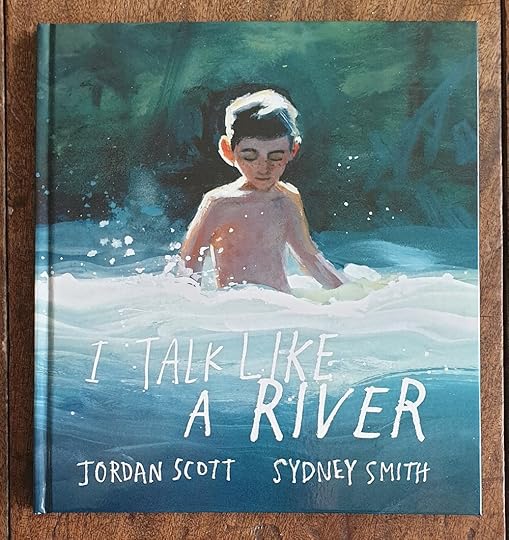
From I Talk Like a River by Jordan Scott, illustrated by Sydney Smith (Walker Books 2021) | Text © 2020 by Jordan Scott | Illustrations © 2020 by Sydney Smith
“An astounding articulation of both what it feels like to be different and how to make peace with it.”– Kirkus Reviews “Unquestionably one of the best picture books of 2020.”– Book Page BUY Us buy uk * I EARN COMMISSION FROM THESE LINKS #AD/AFFRELATED ARTICLESSOURCESI Talk Like a River by Jordan Scott, illustrated by Sydney Smith (Walker Books 2021) ‘I Talk Like River book video’ (Holiday House, Youtube.co.uk, 11 May 2020) The Magic of Collaboration: Jordan Scott and Sydney Smith on I Talk Like a River (The Yarn Podcast, 9 May 2021) Reading a #BookADay: A conversation with Donalyn Miller (School Library Journal, 30 May 2021) Review of the Day: I Talk Like a River by Jordan Scott, ill. Sydney Smith (School Library Journal, 27 August 2020) What if Every Time You Tried to Talk, the Words Got Stuck? (Craig Morgan Teicher, The New York Times, 4 November 2020) Review of I Talk like a River (Luann Toth, The Horn Book Inc., 7 December 2020) I Talk Like a River by author Jordan Scott and illustrator Sydney Smith (Eric Carle Museum, Youtube.co.uk, 27 November 2020)© 2021 BY TIM WARNES(UNLESS OTHERWISE ATTRIBUTED)****USE OF THIRD PARTY COPYRIGHTED MATERIAL FALLS UNDER FAIR USE/FAIR DEALING PRACTICENovember 5, 2021
The Rabbit Listened: Learning how to support our friends

From The Rabbit Listened by Cori Doerrfeld (Scallywag Press, 2019) | Illustration and text © 2018 by Cori Doerrfeld
The Rabbit Listened by Cori Doerrfeld (Scallywag Press, 2019)Good to Read for:understanding difficult emotionsdeveloping empathylearning how to support our friendsSometimes the simplest thing can have the most profound impact. Today’s recommendation, I believe, falls into that category. I can only imagine the positive, cumulative effect The Rabbit Listened will have in the years ahead.It was praised by Kirkus Reviews for showing kids how to ‘process difficult events and provide meaningful support to friends who need it’. (It’s a gentle reminder for us adults, too.)
One day, Taylor decided to build something.
Something new.
Something special.
Something amazing.
Taylor was so proud.
The illustration shows us Taylor’s fantastic project: a tower of building blocks. ‘But then, out of nowhere’, disaster strikes! A flock of birds swoops through the tower, causing Taylor’s hard work to come crashing down.
[image error]From The Rabbit Listened by Cori Doerrfeld (Scallywag Press, 2019) | Illustration and text © 2018 by Cori Doerrfeld
Doerrfeld leaves it to her emotive illustrations to show how Taylor is feeling. (Her love for animation is apparent in her expressive characters.) This simple premise (which is an excellent metaphor for those unexpected events that come out of nowhere and turn life upside down) is the inciting incident that the whole story is pinned upon.
Taylor is tearful and alone, huddled alongside the trashed tower.

From The Rabbit Listened by Cori Doerrfeld (Scallywag Press, 2019) | Illustration and text © 2018 by Cori Doerrfeld
A chicken stops by and encourages Taylor to talk about it.
But Taylor didn’t feel like talking.
So the chicken left.
One by one, more animals appear to express sympathy and profer advice and solutions.
They tell Taylor how to act.
“Let’s shout about it! Garr! RARRR! GRAAAAR!” says the bear.

From The Rabbit Listened by Cori Doerrfeld (Scallywag Press, 2019) | Illustration and text © 2018 by Cori Doerrfeld
The elephant tries to fix it: “We just need to remember exactly the way things were.”
The hyena laughs it off.
The ostrich sticks her hand in the sand and pretend’s nothing’s happened.
The kangaroo wants to simply tidy up the mess.

From The Rabbit Listened by Cori Doerrfeld (Scallywag Press, 2019) | Illustration and text © 2018 by Cori Doerrfeld
(The snake is the most thought-provoking – and again, adds something that kids will connect with: “Shhhhh. Let’sss go and knock down someone else’sss,” it hisses.)

From The Rabbit Listened by Cori Doerrfeld (Scallywag Press, 2019) | Illustration and text © 2018 by Cori Doerrfeld
But Taylor didn’t feel like doing anything with anybody.
So eventually, they all left….
until Taylor was all alone.
We can probably all identify with at least one of the well-meaning animals. But they do nothing to support Taylor. They want to fix the problem, but are unable to provide comfort.
Thank goodness Taylor’s final visitor ‘takes a more passive approach.’ [Booktrust]
In the quiet, Taylor didn’t even notice the rabbit.
But it moved closer.
Until Taylor could feel its warm body.
Together they sat in silence until Taylor said, “Please stay with me.”
And then what does the rabbit do?
The rabbit listens.
Because sometimes, there are no answers or solutions.
Sometimes, when we experience pain and loss, we need to process our thoughts and emotions by talking about them without judgment or well-meaning advice.
(That’s why I’m such a big fan of therapy.)
The rabbit listened as Taylor remembered…
And laughed.
The rabbit listened to Taylor’s plans to hide…
To throw everything away…
To ruin things for someone else.
Through it all, the rabbit never left.
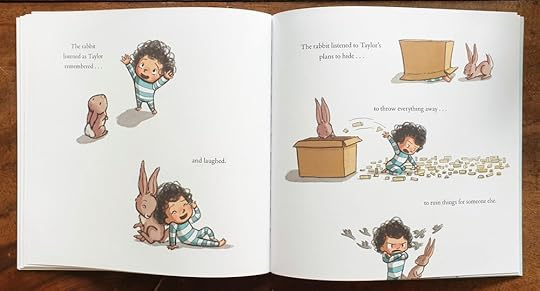
From The Rabbit Listened by Cori Doerrfeld (Scallywag Press, 2019) | Illustration and text © 2018 by Cori Doerrfeld
The Rabbit Listened, notes Booktrust, emphasises ‘the importance of listening, reflecting and allowing time to come to terms with difficult emotions’. Demonstrating how to find positive ways to move forward, it ‘encourages children to explore strategies to manage turbulent feelings, helping them to develop their emotional intelligence.’
I’m fascinated to learn where creative ideas come from. Perhaps unsurprisingly, The Rabbit Listened comes from a place of profound loss.
Two close friends of Doerrfeld experienced the death of their child. “They were very frustrated with their family and friends, because nobody really knew what to say or do,” says Doerrfeld. “And as much as I tried to be there for them, I also felt very helpless. What do you do when someone is dealing with something so inconceivable?” The event reminded Doerrfeld of a childhood friend who had ‘found great comfort in rabbits after his brother passed away.’
“He wrote about how important his pet rabbits were in helping him cope with his grief because they were a quiet, peaceful presence he could turn to,” explains Doerrfeld. “[H]e didn’t need anyone telling him what to do or feel. What he needed and found in those rabbits was a calm, reliable presence that was simply willing to listen.”
So, I went on a long walk with my dog, thinking about my friends and thinking about this letter, and the story for The Rabbit Listened just came to me. It’s almost hard to explain. I remember I ran home, wrote it down and drew rough little sketches, all in a day.
– Interview With “The Rabbit Listened” Author Cori Doerrfeld
Seeing her friends’ experience made Doerrfeld realise how lacking so many of us are in emotional intelligence. She acknowledges that it’s ‘hard to know what to do in these kinds of situations, and even the best intentions can complicate things.’
That’s the power of picture books like The Rabbit Listened. They help develop empathy - (the ability to put yourself in someone else’s shoes) and start conversations about difficult emotions (that many adults shy away from). By using picture books as tools to engage with kids at this level, we equip them to thrive in future relationships and make the world a better place.
Because sometimes, when there is nothing to be done or said that can help, the best thing to say is nothing at all.
Doerrfeld describes The Rabbit Listened as “somehow general enough that anyone can see themselves in the book, yet specific enough that people know exactly what it’s about.”
She achieves this by:
constructing the text so that Taylor (a gender-neutral name) is never referred to with gender pronouns. (She also makes Taylor look as neutral as possible.)
making the inciting incident (the collapse of the block tower) age-appropriate and relatable for young kids while allowing for deeper discussion with older children.
Elizabeth Bird’s review for School Library Journal articulates the book’s significance perfectly:
The event that leads to Taylor’s misery is an out-of-the-blue disaster that strikes without warning or reason. And just like that, you have a book that can be applied to broad disasters like hurricanes, school shootings, or terrorist attacks or personal ones like the death of a loved one.
There’s truth in the adage, time is a healer.
Rabbit listens as Taylor talks. In doing so, they navigate some turbulent emotions and find light at the end of the tunnel:
And when the time was right, the rabbit listened to Taylor’s plan to build again.
The final spread is a satisfying conclusion that takes us full circle. Taylor is now energized and excited to rebuild the tower (represented by imagined blocks rising high once more).
“It’s going to be amazing,” says Taylor confidently.

From The Rabbit Listened by Cori Doerrfeld (Scallywag Press, 2019) | Illustration and text © 2018 by Cori Doerrfeld
STORIES WORTH SHARINGThe Rabbit Listened by Corri DoerrfeldGood to Read for:
Understanding difficult emotions
Developing empathy
Modelling how to support friends
Good to ReadFor navigating difficult emotions
Penguin by Polly Dunbar
A Little Bit Worried by Ciara Gavin & Tim Warnes
The Colour Monster by Anna Llénas
Tiger Lily by Gwen Millward
Me and My Fear by Francesca Sanna
BUY THE BOOKPowered by Bookshop.org
Supporting independent bookshops

From The Rabbit Listened by Cori Doerrfeld (Scallywag Press, 2019) | Illustration and text © 2018 by Cori Doerrfeld
“Sensitive and insightful … an ideal starting point for discussion about how it feels when things go wrong.” – BOOK TRUST“[A] deeply moving story to be read an explored” – CHILDREN’S BOOK IRELAND Buy uk buy us * I EARN COMMISSION FROM THESE LINKS #AD/AFF Related Articles Sign up for your free weekly email with more story recommendations and tipsMake the most of those opportunities to connect with your kids
Email Address Sign UpWe respect your privacy.
Thank you! SOURCESThe Rabbit Listened by Cori Doerrfeld (Scallywag Press, 2019)Interview with ‘The Rabbit Listened’ Author Cori Doerrfeld (Imaginationlibrary.com, 27 June 2019) Maria Marshall, Making Nature Fun (Mariamarshall.com) The Rabbit Listened (Design of the Picture Book) An Interview with Author/Illustrator Cori Doerrfeld (wisconsinscbwi.wordpress.com, 13 August 2019) The Rabbit Listen (Booktrust.org.uk)Review of the Day: The Rabbit Listened by Cori Doerrfeld (School Library Journal, 29 May 2018) The Rabbit Listened (Kirkus Reviews)© 2021 BY TIM WARNES(UNLESS OTHERWISE ATTRIBUTED)****USE OF THIRD PARTY COPYRIGHTED MATERIAL FALLS UNDER FAIR USE/FAIR DEALING PRACTICE.My Life in Books
For lovers of kid lit, this memoir - My Life in Books - is intended to give you the confidence and encouragement to share your own passion; to help you make lasting connections through kids’ books.
Originally posted at www.timwarnes.com ...more
- Tim Warnes's profile
- 30 followers



